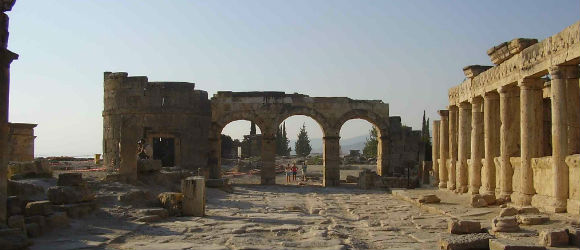The presence of a hot spring at Hierapolis and the spectacular calcium deposits from its water spilling over the nearby hillside suggest that there should be evidence of an early settlement there. The oldest Inscription found so far, however, indicates it was founded by Eumenes II, king of Pergamon, in the latter part of the second century B.C.; it soon became a busy industrial center.
Pagan worship in the city centered around Cybele, Apollo, Artemis, Men, Poseidon, and Pluto. Underneath the Temple of Apollo has been found the Plutonium, an opening in the earth from which a noxious gas still comes. The temple is between the pool where the hot spring rises and the large theater on the side of the hill. To the north along the rim of the plateau is a long avenue of tombs.
Traditionally St. Philip is connected with the early church in Hierapolis. Fairly recently Italian archeologlsts have discovered his Martyrium, an octagonal chamber forming a double cross surrounded by a square. This is almost due north of the theater, also on the side of the hill. It was a fifth century A.D. building and did not last much more than 100 years. No tomb was found with it although that was expected. There are several ruins of churches, one not far from the baths, one on the main road leading to the necropolis.
Hierapolis is listed in the New Testament along with Laodicea as the center of Epaphras’s work (Colos-sians 4:13). This was at the time Paul was writing to strengthen the message Epaphras was preaching and to condemn the “people who go in for self-mortification and angel-worship” (Colossians 2:18). Another less well-known resident of Hierapolis was Papias, a disciple of St. John and the author of the lost book called the Sayings of Jesus.
While Epaphras was is that area, a young slave was growing up in Hierapolis, a boy whose original name is unknown but whom we call by the Greek for “Acquired”, Epictetus. In his Discourses Epictetus often talks about the perfect missionary whose bed was the ground, whose only house the earth and sky and a shabby cloak, and who must love those who misuse him in the service of God. One wonders what the influence of those early Christians, many of whom were slaves themselves, was on this Stoic philosopher.
Hierapolis,


What an absolutely incredible sight this is, it is unbeleivable what these builders were capable of in days long gone. Unfortunately we werent allowed to walk in the Pamukalle like a lot of previous reviews but this spectacular feature will stay in my memory forever.
Very conveniently located atop the Travertines and included in the admission price of 20TL from memory.
The ancient city's ruins are vast; some well preserved, some preserved enough to get a feel for what it may have looked like, but mostly flattened by earthquakes.
There were apparently up to 100,000 people living there in its heyday.
Definitely worth the time…
If you're a history buff, you'll enjoy Hierapolis and its significance to the travertines. But the actual site was not as well-preserved as the other ancient Greek-Roman sites I've seen in the Middle East, and Europe.
We have been travelling throughout Europe visiting many ancient sites/ ruins. This one was my favorite as it combined history with the natural phenomenon of the travertine terraces and thermal pools. We recommend visiting in the late afternoon after 4 pm as the tour buses have left so it is not crowded and we got a discount at the Antique…
than just ruins, this unique site has the exotic and almost alien-like hot water springs that absolutely transform the landscape. While a bit out of the way, worth a visit — splash around in the water and soak up the gorgeous vistas and ruins.
The calcium travertines were great, especially walking on them. Best to start from the bottom and go to the top ( and back down ) It's thankful that one is able to walk ( in bare feet – no shoes allowed ) across and experience the calcium deposits. Obviously no Greens in Turkey !!
The Hierapolis remains although impressive do…
Hierapolis was fabulous..
You will like the natural springs and the natural tavertines created by the calcium carbonate crystals that gives a snowy white appearanceo
We did a guides tour and some guests were late so the tour was cut by half an hour. The tour also stopped for lunch at a hotel. With hindsight we would have preferred to get straight out to Pamukkale to allow us to spend more time in the mineral baths and walk around Hierapolis. As it was we had…
Pamukkale means Cotton Castle and you won't be disappointed. Take off your shoes and walk on the wonderful Travertine rock. It looks like snow, but it really is rock.
Hierapolis is a treasure that needs to be explored. Allow at least two to three hours for a visit here. Three if you include a swim in Cleopatra's pool. Add two…